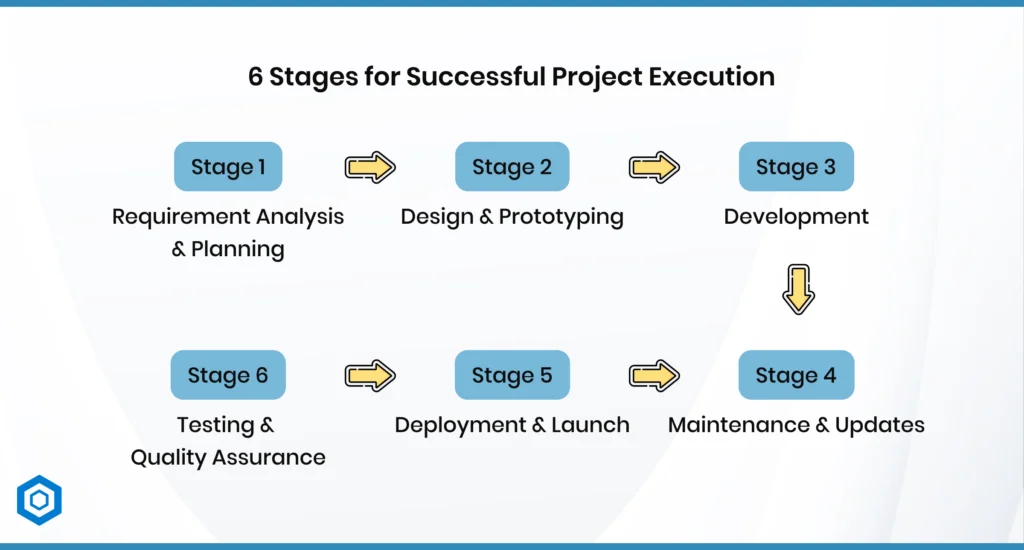
Software Development Procedure: 6 Essential Stages for Successful Project Execution
21 MARCH
Software development is an organized process of creating software that delivers an idea of an application or a system. Similar to any Software Development Procedure, whether it’s an application for an individual’s handheld device or for an organization, it is recommended that one should follow a certain Software Development Procedure that aids in the attainment of efficiency, scalability, and reliability.
The newly emerging market reveals a growing trend as firms strive to develop their presence digitally throughout industries. Indeed, those organizations that approach software development systematically enjoy increased competitive advantage, increased cost efficiency, and a better customer experience. The revenue in the Software market is projected to exhibit a steady annual growth rate of 4.87% from 2025 to 2029.
This article aims to show six important phases of each SDLC and the activities involved, technologies used, and important practices during the phases. This article will also provide knowledge about front-end development, back-end development, offshore software testing services, and why it is important to hire a dedicated software development team.

Stage 1: Requirement Analysis and Planning
Good software projects always begin with a proper analysis of the needs of the project. It involves the identification and documentation of requirements- business requirements and users’ requirements. These are the expectations of the project such as with whom, what should be done, and how it should be done among the developers, project managers, and the clients.
Key Activities:
- The features of the target audience and setting the parameters of the software’s functionality
- Analyzing technical and financial feasibility audits and assessments to check the possibility
- Writing a Software Requirement Specification (SRS) document
- Choosing the right Mobile App Development Company or development team
Reiterative work means that the team has experience in effective project management and coding and testing software products. Outsourcing some tasks like offshore software testing services can minimize cost and, at the same tim,e improve quality.
Stage 2: Design and Prototyping
Once the requirements are established, it is easier to establish the software structure and to work on the user interface. This phase determines the appearance and characteristics of the software and the development of the application.
Key Activities:
- Creating wireframes, UI/UX designs, and mockups
- Choosing the right tech stack for front-end and back-end development
- Designing database architecture and application workflows
- Developing a prototype to visualize functionalities
Navigation and especially its responsiveness is crucial in the design stage of mobile applications. Hiring a Mobile Application Development Company assists in the enhancement of the mobile application in terms of design and effectiveness.
Stage 3: Development (Coding & Implementation)
The implementation phase is the last phase, where the developers write the source code to implement what has been designed. These two aspects of software development distinguish it as a field that is unique in the broad sense of the term engineering.
Front-End Development
It takes into account the graphical user interface and the ways the users can address it. It involves:
- Using languages like HTML, CSS, and JavaScript
- Frameworks such as React, Angular, or Vue.js
- Ensuring cross-platform compatibility and responsiveness
Back-End Development
Back-end development includes concerns with server-side scripting, databases, and application programming interfaces (APIs). This includes:
- Programming languages like Python, Java, PHP, or Node.js
- Database management using SQL or NoSQL solutions
- API development to integrate third-party services
Having a combination of front-end development and back-end development avoids the building of a large application, which may end up not being capable of performing as required.
Stage 4: Testing and Quality Assurance
To understand the risks of bugs, performance problems and security threats, testing is highly recommended before implementation. Offshore Software Testing Services, therefore, has received a great reception from companies that want top-quality testing while minimizing cost.
Types of Testing:
- Unit Testing: Checks individual components for functionality
- Integration Testing: Ensures smooth interaction between different modules
- Performance Testing: Evaluates speed, responsiveness, and stability
- Security Testing: Identifies vulnerabilities and safeguards data
Using automated and manual testing methods helps improve software efficiency and reliability. A dedicated software testing team ensures that all defects are fixed before launch.
Stage 5: Deployment and Launch
After the software has gone through all the testing phases, it is then ready for deployment. This involves creating an environment for implementation, making adjustments in implementation servers, and deployment of the software to the final users.
Key Activities:
- Deploying on cloud platforms like AWS, Azure, or Google Cloud
- Setting up CI/CD pipelines for continuous integration and delivery
- Conducting final user acceptance testing (UAT)
- Launching the application in app stores or web servers
A smooth deployment strategy ensures minimal downtime and a successful product launch.
Stage 6: Maintenance and Updates
Software development doesn’t end with deployment. Continuous monitoring, maintenance, and updates are crucial to keep the software functional and secure.
Key Activities:
- Fixing bugs and optimizing performance
- Adding new features based on user feedback
- Enhancing security to prevent cyber threats
- Scaling the infrastructure as user demand increases
When you hire a software development team, it ensures long-term support, making necessary updates and improvements based on market trends.
Why You Should Hire a Software Development Team
The process of developing its own applications has become challenging for many companies, mainly because of internal constraints. Working with specialists increases the opportunities available for the following:
- Skilled developers for both front-end and back-end development
- Expertise in various programming languages and frameworks
- Cost-effective solutions through offshore software testing services
- Increased rates of software development and better quality of the resulting products
Actually, working with a professional Mobile App Development Company will help to avoid a violation of standard practices and guidelines.
Conclusion
Adhering to a set Software Development Procedure is rewarding, leading to improved efficiency, scalability, and end-user courtesy. Each of these phases in the Software Development Procedure is very significant in driving the overall process and providing optimum software solutions.
Whether you require website development, offshore software testing services, or hiring a dedicated software development team, it is always right to opt for a long-term Software Development Procedure approach.





